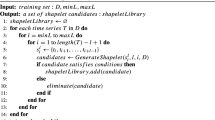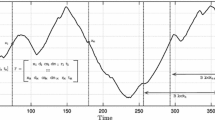Abstract
In the research area of time series classification, the ensemble shapelet transform algorithm is one of the state-of-the-art algorithms for classification. However, its high time complexity is an issue to hinder its application since its base classifier shapelet transform includes a high time complexity of a distance calculation and shapelet selection. Therefore, in this paper we introduce a novel algorithm, i.e., short isometric shapelet transform (SIST), which contains two strategies to reduce the time complexity. The first strategy of SIST fixes the length of shapelet based on a simplified distance calculation, which largely reduces the number of shapelet candidates as well as speeds up the distance calculation in the ensemble shapelet transform algorithm. The second strategy is to train a single linear classifier in the feature space instead of an ensemble classifier. The theoretical evidence of these two strategies is presented to guarantee a near-lossless accuracy under some preconditions while reducing the time complexity. Furthermore, empirical experiments demonstrate the superior performance of the proposed algorithm.












Similar content being viewed by others
References
Apostolico A, Bock ME, Lonardi S (2002) Monotony of surprise and large-scale quest for unusual words. J Comput Biol J Comput Mol Cell Biol 10(3–4):283–311
Bagnall A, Lines J, Hills J, Bostrom A (2015) Time-series classification with cote: the collective of transformation-based ensembles. IEEE Trans Knowl Data Eng 27:2522–2535
Bagnall A, Lines J, Bostrom A, Large J, Keogh EJ (2016) The great time series classification bake off: a review and experimental evaluation of recent algorithmic advances. Data Min Knowl Discov 31:606–660
Bagnall AJ, Janacek GJ (2014) A run length transformation for discriminating between auto regressive time series. J Classif 31:154–178
Batista GEAPA, Keogh EJ, Tataw OM, de Souza VMA (2013) Cid: an efficient complexity-invariant distance for time series. Data Min Knowl Discov 28:634–669
Baydogan MG, Runger GC (2015) Time series representation and similarity based on local autopatterns. Data Min Knowl Discov 30:476–509
Baydogan MG, Runger GC, Tuv E (2013) A bag-of-features framework to classify time series. IEEE Trans Pattern Anal Mach Intell 35:2796–2802
Bostrom A, Bagnall A (2015) Binary shapelet transform for multiclass time series classification. Trans Large Scale Data Knowl Cent Syst 32:24–46
Bostrom A, Bagnall A, Lines J (2016) Evaluating improvements to the shapelet transform
Chen H, Yao X (2009) Regularized negative correlation learning for neural network ensembles. IEEE Trans Neural Netw 20(12):1962–1979
Chen H, Yao X (2010) Multiobjective neural network ensembles based on regularized negative correlation learning. IEEE Trans Knowl Data Eng 22(12):1738–1751
Chen H, Tiňo P, Yao X (2009) Predictive ensemble pruning by expectation propagation. IEEE Trans Knowl Data Eng 21(7):999–1013
Chen H, Tang F, Tino P, Yao X (2013) Model-based kernel for efficient time series analysis. In: Proceedings of the 19th ACM SIGKDD international conference on Knowledge discovery and data mining, pp 392–400
Chen H, Tiňo P, Rodan A, Yao X (2013) Learning in the model space for cognitive fault diagnosis. IEEE Trans Neural Netw Learn Syst 25(1):124–136
Chen H, Tiňo P, Yao X (2014) Cognitive fault diagnosis in tennessee eastman process using learning in the model space. Comput Chem Eng 67:33–42
Chen H, Tang F, Tino P, Cohn AG, Yao X (2015) Model metric co-learning for time series classification. In: Twenty-fourth international joint conference on artificial intelligence, pp 3387–3394
Corduas M, Piccolo D (2013) Clustering and classification by the autoregressive metric
Deng H, Runger GC, Tuv E, Martyanov V (2013) A time series forest for classification and feature extraction. Inf Sci 239:142–153
Gionis A, Mannila H (2003) Finding recurrent sources in sequences. In: RECOMB
Gong Z, Chen H (2018) Sequential data classification by dynamic state warping. Knowl Inf Syst 57(3):545–570
Górecki T, Luczak M (2012) Using derivatives in time series classification. Data Min Knowl Discov 26:310–331
Górecki T, Luczak M (2014) Non-isometric transforms in time series classification using DTW. Knowl Based Syst 61:98–108
Grabocka J, Schilling N, Wistuba M, Schmidt-Thieme L (2014) Learning time-series shapelets. In: KDD
Guido RC (2018) Fusing time, frequency and shape-related information: Introduction to the discrete shapelet transform’s second generation (dst-ii). Inf Fusion 41:9–15
Hills J, Lines J, Baranauskas E, Mapp J, Bagnall A (2013) Classification of time series by shapelet transformation. Data Min Knowl Discov 28:851–881
Hou L, Kwok JT, Zurada JM (2016) Efficient learning of timeseries shapelets. In: AAAI
Jeong Y, Jeong MK, Omitaomu OA (2011) Weighted dynamic time warping for time series classification. Pattern Recognit 44:2231–2240
Kate RJ (2015) Using dynamic time warping distances as features for improved time series classification. Data Min Knowl Discov 30:283–312
Keogh EJ, Rakthanmanon T (2013) Fast shapelets: a scalable algorithm for discovering time series shapelets. In: SDM
Li Y, Hong J, Chen H (2019) Short sequence classification through discriminable linear dynamical system. IEEE Trans Neural Netw Learn Syst 30(11):3396–3408
Lin J, Keogh EJ, Wei L, Lonardi S (2007) Experiencing sax: a novel symbolic representation of time series. Data Min Knowl Discov 15:107–144
Lin J, Khade R, Li Y (2012) Rotation-invariant similarity in time series using bag-of-patterns representation. J Intell Inf Syst 39:287–315
Lines J, Bagnall A (2014) Time series classification with ensembles of elastic distance measures. Data Min Knowl Discov 29:565–592
Lines J, Taylor S, Bagnall A (2016) Hive-cote: the hierarchical vote collective of transformation-based ensembles for time series classification. In: 2016 IEEE 16th international conference on data mining (ICDM) pp 1041–1046
Lyu S, Tian X, Li Y, Jiang B, Chen H (2019) Multiclass probabilistic classification vector machine. IEEE Trans Neural Netw Learn Syst 1–14
Marteau PF (2009) Time warp edit distance with stiffness adjustment for time series matching. IEEE Trans Pattern Anal Mach Intell 31:306–318
Mei J, Liu M, Wang YF, Gao H (2016) Learning a mahalanobis distance-based dynamic time warping measure for multivariate time series classification. IEEE Trans Cybern 46:1363–1374
Quevedo J, Chen H, Cugueró MÀ, Tino P, Puig V, Garciá D, Sarrate R, Yao X (2014) Combining learning in model space fault diagnosis with data validation/reconstruction: Application to the Barcelona water network. Eng Appl Artif Intell 30:18–29
Rakthanmanon T, Campana BJL, Mueen A, Batista GEAPA, Westover MB, Zhu Q, Zakaria J, Keogh EJ (2013) Addressing big data time series: mining trillions of time series subsequences under dynamic time warping. TKDD 7:10:1-10:31
Roychoudhury S, Ghalwash MF, Obradovic Z (2017) Cost sensitive time-series classification. In: ECML/PKDD
Schäfer P (2014) The boss is concerned with time series classification in the presence of noise. Data Min Knowl Discov 29:1505–1530
Schäfer P, Leser U (2017) Fast and accurate time series classification with weasel. In: CIKM
Senin P, Malinchik S (2013) Sax-vsm: Interpretable time series classification using sax and vector space model. 2013 IEEE 13th international conference on data mining, pp 1175–1180
Sharabiani A, Darabi H, Rezaei A, Harford S, Johnson H, Karim F (2017) Efficient classification of long time series by 3-d dynamic time warping. IEEE Trans Syst Man Cybern Syst 47:2688–2703
Smyth P (1996) Clustering sequences with hidden markov models. In: NIPS
Stefan A, Athitsos V, Das G (2013) The move-split-merge metric for time series. IEEE Trans Knowl Data Eng 25:1425–1438
Yang D, Chen H, Song Y, Gong Z (2017) Granger causality for multivariate time series classification. In: 2017 IEEE international conference on big knowledge (ICBK), pp 103–110
Ye L, Keogh EJ (2010) Time series shapelets: a novel technique that allows accurate, interpretable and fast classification. Data Min Knowl Discov 22:149–182
Acknowledgements
We thank anonymous reviewers for their very useful comments and suggestions. This research is supported in part by the National Key Research and Development Program of China under Grant No. 2016YFB1000905, the National Natural Science Foundation of China under Grant No. 91746209, and the Fundamental Research Funds for the Central Universities.
Author information
Authors and Affiliations
Corresponding author
Additional information
Publisher's Note
Springer Nature remains neutral with regard to jurisdictional claims in published maps and institutional affiliations.
Rights and permissions
About this article
Cite this article
Shu, W., Yao, Y., Lyu, S. et al. Short isometric shapelet transform for binary time series classification. Knowl Inf Syst 63, 2023–2051 (2021). https://doi.org/10.1007/s10115-021-01583-3
Received:
Revised:
Accepted:
Published:
Issue Date:
DOI: https://doi.org/10.1007/s10115-021-01583-3




